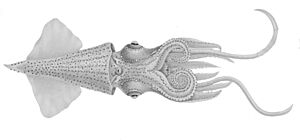Hooked enope squid facts for kids
Quick facts for kids Hooked enope squid |
|
|---|---|
 |
|
| Conservation status | |
| Scientific classification | |
| Synonyms | |
|
The Enoploteuthis leptura, also known as the hooked enope squid, is a fascinating type of squid. It belongs to a group of squids called the Enoploteuthidae family. This squid is special because it's the main example for its genus (a smaller group) called Enoploteuthis, and also for its whole family.
What Does the Hooked Enope Squid Look Like?
The hooked enope squid gets its name from the hooks on its arms! It has more hooks on its fourth pair of arms than on the first three pairs. Male squids have many tiny bumps, called papillae, on the inside of their first three arms.
One of the male squid's right fourth arms is special. It's called a hectocotylised arm. This arm has a flap that helps with reproduction. On this arm, there are about six pairs of hooks near the end, opposite the flap. The other side of the arm also has small flaps.
The squid's tentacles are long and thin. The tentacular club (the wider part at the end) is narrow. It has two rows of hooks. One row has 6-7 large hooks, and the other has 4-5 smaller ones. The very end of the tentacle, called the dactylus, has 10-15 suckers in two rows.
This squid also has special light-producing organs called photophores. On the front of its mantle (the main body), there are six rows of these lights. A seventh row curves to join another row. There's also a broken row of lights along the front edge of the mantle. The underside of its head has six rows of photophores too. These squids can grow up to 92 millimeters (about 3.6 inches) long.
Where Does the Hooked Enope Squid Live?
The hooked enope squid has been found in many parts of the Atlantic Ocean. This includes the Gulf of Guinea in Africa, and areas from Bermuda and Madeira in the north, all the way down to Brazil and southwestern Africa. Another type of squid, Enoploteuthis magnoceani, found in the Indo-Pacific region, is sometimes thought to be a subspecies of E. leptura.
Life in the Ocean: Habitat and Life Cycle
The hooked enope squid is a mesopelagic squid. This means it lives in the middle depths of the ocean, usually in warmer waters of the Atlantic.
Scientists have studied the growth of these squids using their statoliths (small balance organs). They found that Enoploteuthis leptura has a short life. It lives for about 6 months. Males become ready to reproduce in about 45–60 days. Females take a bit longer, around 80–90 days. The oldest males found lived up to 153 days and reached 72mm in length. Females lived up to 143 days and grew to 92mm.
In the Gulf of Guinea, these squids lay eggs for most of the year, up to September. There are two main times when they lay the most eggs: in January and again in June–July.
This squid is also a vertical diel migrant. This means it moves up and down in the water column every day. During the day, they stay in deeper waters. At night, they swim closer to the surface to find food.


